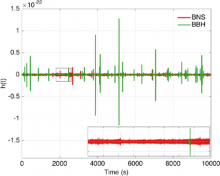
Abstract
The LIGO Scientific and Virgo Collaborations have announced the first detection of gravitational waves from the coalescence of two neutron stars. The merger rate of binary neutron stars estimated from this event suggests that distant, unresolvable binary neutron stars create a significant astrophysical stochastic gravitational-wave background. The binary neutron star background will add to the background from binary black holes, increasing the amplitude of the total astrophysical background relative to previous expectations. In the Advanced LIGO-Virgo frequency band most sensitive to stochastic backgrounds (near 25 Hz), we predict a total astrophysical background with amplitude ΩGW(f=25Hz)=1.8+2.7−1.3×10−9 with 90% confidence, compared with ΩGW(f=25Hz)=1.1+1.2−0.7×10−9 from binary black holes alone. Assuming the most probable rate for compact binary mergers, we find that the total background may be detectable with a signal-to-noise-ratio of 3 after 40 months of total observation time, based on the expected timeline for Advanced LIGO and Virgo to reach their design sensitivity.